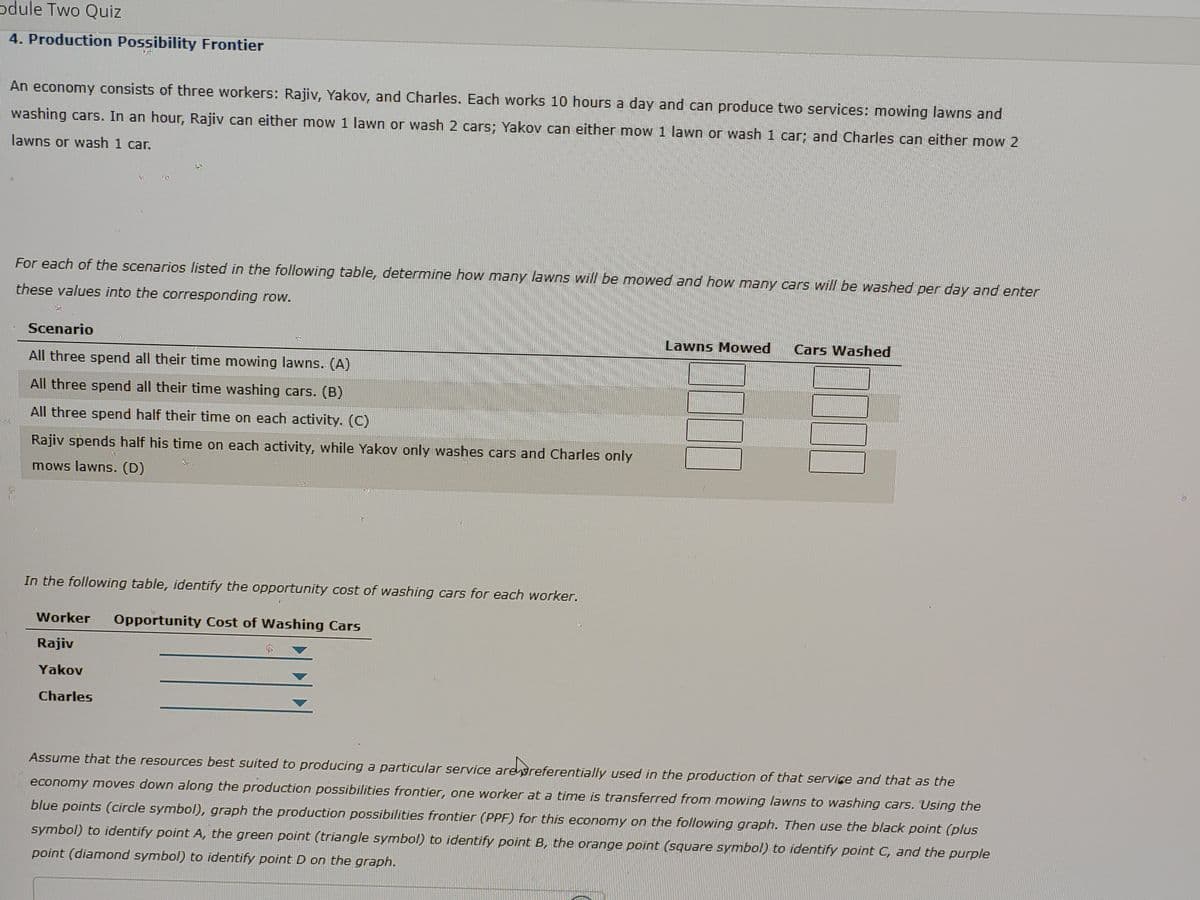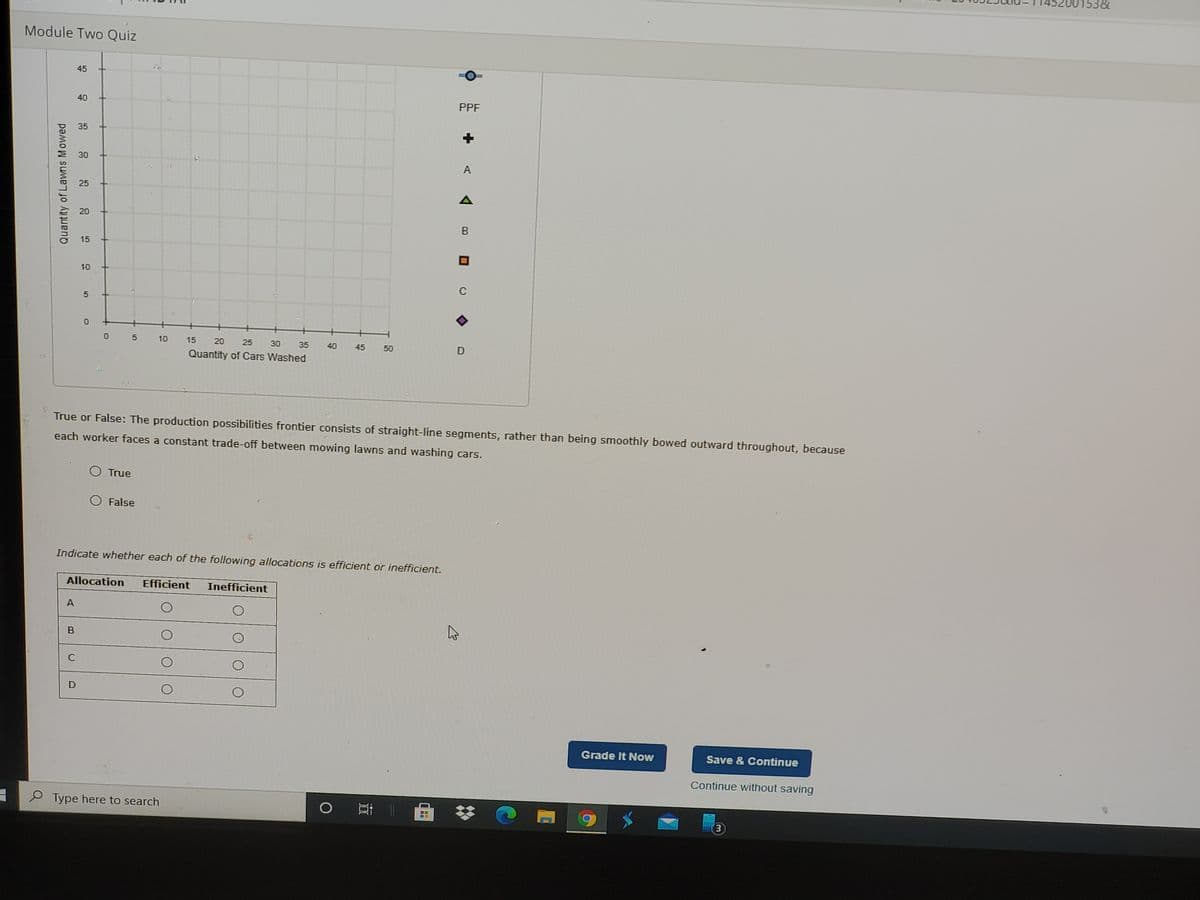An economy consists of three workers: Rajiv, Yakov, and Charles. Each works 10 hours a day and can produce two services: mowing lawns and washing cars. In an hour, Rajiv can either mow 1 lawn or wash 2 cars; Yakov can either mow 1 lawn or wash 1 car; and Charles can either mow 2 lawns or wash 1 car. For each of the scenarios listed in the following table, determine how many lawns will be mowed and how many cars will be washed per day and enter these values into the corresponding row. Scenario Lawns Mowed Cars Washed All three spend all their time mowing lawns. (A) All three spend all their time washing cars. (B) All three spend half their time on each activity. (C) Rajiv spends half his time on each activity, while Yakov only washes cars and Charles only mows lawns. (D)
An economy consists of three workers: Rajiv, Yakov, and Charles. Each works 10 hours a day and can produce two services: mowing lawns and washing cars. In an hour, Rajiv can either mow 1 lawn or wash 2 cars; Yakov can either mow 1 lawn or wash 1 car; and Charles can either mow 2 lawns or wash 1 car. For each of the scenarios listed in the following table, determine how many lawns will be mowed and how many cars will be washed per day and enter these values into the corresponding row. Scenario Lawns Mowed Cars Washed All three spend all their time mowing lawns. (A) All three spend all their time washing cars. (B) All three spend half their time on each activity. (C) Rajiv spends half his time on each activity, while Yakov only washes cars and Charles only mows lawns. (D)
Essentials of Economics (MindTap Course List)
8th Edition
ISBN:9781337091992
Author:N. Gregory Mankiw
Publisher:N. Gregory Mankiw
Chapter2: Thinking Like An Economist
Section: Chapter Questions
Problem 4PA
Related questions
Question

Transcribed Image Text:odule Two Quiz
4. Production Possibility Frontier
An economy consists of three workers: Rajiv, Yakov, and Charles. Each works 10 hours a day and can produce two services: mowing lawns and
washing cars. In an hour, Rajiv can either mow 1 lawn or wash 2 cars; Yakov can either mow 1 lawn or wash 1 car; and Charles can either mow 2
lawns or wash 1 car.
For each of the scenarios listed in the following table, determine how many lawns will be mowed and how many cars will be washed per day and enter
these values into the corresponding row.
Scenario
Lawns Mowed
Cars Washed
All three spend all their time mowing lawns. (A)
All three spend all their time washing cars. (B)
All three spend half their time on each activity. (C)
Rajiv spends half his time on each activity, while Yakov only washes cars and Charles only
mows lawns. (D)
In the following table, identify the opportunity cost of washing cars for each worker.
Worker
Opportunity Cost of Washing Cars
Rajiv
Yakov
Charles
Assume that the resources best suited to producing a particular service arereferentially used in the production of that service and that as the
economy moves down along the production possibilities frontier, one worker at a time is transferred from mowing lawns to washing cars. Using the
blue points (circle symbol), graph the production possibilities frontier (PPF) for this economy on the following graph. Then use the black point (plus
symbol) to identify point A, the green point (triangle symbol) to identify point B, the orange point (square symbol) to identify point C, and the purple
point (diamond symbol) to identify point D on the graph.

Transcribed Image Text:3&
Module Two Quiz
45
40
PPF
35
+
30
A
25
A
20
B
15
10
C
0 5 10
15
20
25
30
35
40
45
50
D
Quantity of Cars Washed
True or False: The production possibilities frontier consists of straight-line segments, rather than being smoothly bowed outward throughout, because
each worker faces a constant trade-off between mowing lawns and washing cars.
O True
O False
Indicate whether each of the following allocations is efficient or inefficient.
Allocation
Efficient
Inefficient
A
B
C
Grade It Now
Save & Continue
Continue without saving
P Type here to search
3
Quantity of Lawns Mowed
5
Expert Solution
This question has been solved!
Explore an expertly crafted, step-by-step solution for a thorough understanding of key concepts.
This is a popular solution!
Trending now
This is a popular solution!
Step by step
Solved in 2 steps with 1 images

Knowledge Booster
Learn more about
Need a deep-dive on the concept behind this application? Look no further. Learn more about this topic, economics and related others by exploring similar questions and additional content below.Recommended textbooks for you

Essentials of Economics (MindTap Course List)
Economics
ISBN:
9781337091992
Author:
N. Gregory Mankiw
Publisher:
Cengage Learning

Exploring Economics
Economics
ISBN:
9781544336329
Author:
Robert L. Sexton
Publisher:
SAGE Publications, Inc

Economics (MindTap Course List)
Economics
ISBN:
9781337617383
Author:
Roger A. Arnold
Publisher:
Cengage Learning

Essentials of Economics (MindTap Course List)
Economics
ISBN:
9781337091992
Author:
N. Gregory Mankiw
Publisher:
Cengage Learning

Exploring Economics
Economics
ISBN:
9781544336329
Author:
Robert L. Sexton
Publisher:
SAGE Publications, Inc

Economics (MindTap Course List)
Economics
ISBN:
9781337617383
Author:
Roger A. Arnold
Publisher:
Cengage Learning



Economics Today and Tomorrow, Student Edition
Economics
ISBN:
9780078747663
Author:
McGraw-Hill
Publisher:
Glencoe/McGraw-Hill School Pub Co